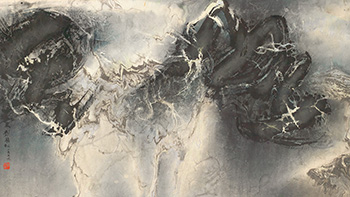Catalogue Note:
As a pioneer for modern ink and wash paintings, Liu Kuo-sung and his creative works have always maintained a revolutionary stance. Much like his own statements, “revolutionize the central stroke,” and “revolutionize the brush”, Liu has never been satisfied with the complacency and stagnancy of traditional Chinese ink and wash painting; instead, he has repeatedly advocated a variety of creative ideas. His inventions of Kuo-sung Paper and Skinned and Wrinkled and Tendon-less Cunfa are examples of his revolt against this millennium-old tradition of an art form, as well as his renewal of traditional Chinese Culture by integrating Western aesthetics and techniques and re-creating a new tradition of ink and wash paintings.
“Down to the Water” can be viewed as an innovative work by Liu Kuo-sung, sprung from contemporary ink and wash paintings; the multiple layers and shades of the ink with color-gradation and shading techniques are enough to express grandeur and magnificence, evoking imagery akin to the galloping Yellow River. The layering of light white and grey ink colors enhance one another, akin to shimmering water in the light, illustrating the Chinese philosophy of ‘blank-leaving (Liubai)’ in landscape paintings. This work expresses a message, that the artist is avidly ambitious in his attempt at spearheading modern abstract ink and wash paintings. Liu once stated, “The Chinese, as an ethnic group, tend to be strong in their abstract thinking; abstract aesthetics are a key element of Chinese art. The essence of Eastern paintings should not be realistic approaches, but rather a conception that integrates mans and the nature.” Such is his central motif in his philosophies towards modernizing Chinese paintings.
“Down to the Water” can be viewed as an innovative work by Liu Kuo-sung, sprung from contemporary ink and wash paintings; the multiple layers and shades of the ink with color-gradation and shading techniques are enough to express grandeur and magnificence, evoking imagery akin to the galloping Yellow River. The layering of light white and grey ink colors enhance one another, akin to shimmering water in the light, illustrating the Chinese philosophy of ‘blank-leaving (Liubai)’ in landscape paintings. This work expresses a message, that the artist is avidly ambitious in his attempt at spearheading modern abstract ink and wash paintings. Liu once stated, “The Chinese, as an ethnic group, tend to be strong in their abstract thinking; abstract aesthetics are a key element of Chinese art. The essence of Eastern paintings should not be realistic approaches, but rather a conception that integrates mans and the nature.” Such is his central motif in his philosophies towards modernizing Chinese paintings.
